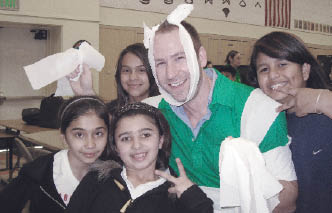 |
|
“Toilet paper cheerleader competition”: Mentor Dennis Goggin, of the Disney Channel, with his new team during team-building exercises at James Madison Middle School. |
Los Angeles
(213) 742-6733
http://www.latm.org
Objective: To help middle school youth who are growing up in challenging urban environments to build self-esteem, confidence and self-worth, and to guide youths to make more positive decisions, perform better in school, build lasting relationships, build their resiliency to adverse situations, realize their full potential and attain far-reaching goals.
In a Nutshell: Los Angeles Team Mentoring (LATM) provides a team mentoring approach targeted toward at-risk youth ages 11 to14 and brings together a group of mentors – consisting of a teacher, a college student and a community/business volunteer – to assist a group of 12 at-risk middle school students. The activity-based curriculum emphasizes team building, leadership development, community service and cultural sensitivity.
Where It Happens: LATM operates at 14 middle schools throughout the Los Angeles Unified School District. The program meets for two hours once a week.
When it Began: 1992.
Who Started It and Who Runs It: The program is an outgrowth of community projects begun in the aftermath of civil unrest in Los Angeles in 1992. Feedback from local students showed they would feel more comfortable and willing to participate in a mentoring program if they were working with their peers in a setting with more than one adult, rather than one-on-one. Team-based mentoring was piloted in inner-city Los Angeles middle schools, beginning at Horace Mann Middle School in South Central Los Angeles.
LATM was led for its first eight years by Barbara Lehrner. In 2000, Brett Andrews and Liza Bray, two of the agency’s senior vice presidents, succeeded Lehrner as co-directors. Bray is now the sole executive director. Other paid staff members include a program director, a program manager and a program coordinator. There are more than 440 volunteer mentors.
Obstacle: Recruiting enough mentors to satisfy demand.
How They Overcame It: Three years ago LATM implemented a corporate adoption model, in which corporations are invited to adopt an LATM middle school site and provide the community mentors, financial support and in-kind donations. Nine of the 14 schools have been adopted by corporate sponsors.
Cost: For 2010, the yearly operating budget is roughly $1.1 million.
Who Pays: The principal source of fundraising comes from LATM’s annual “Summer Soiree.” LATM also has strong support from key community constituents and from the Los Angeles Unified School District.
Who Else Has Kicked In: LATM partners with the following groups: Asian American Drug Abuse Program; California State University, Northridge; California State University, Long Beach; California State University, Dominguez Hills; Capital Group; City of Los Angeles – GRYD Initiative; Comcast Entertainment Group; Disney Channel; Disney Consumer Products; Ernst & Young; Fox Networks Group; Habitat for Humanity; Junior League of Los Angeles; Monterey Park Police Department; Mount Saint Mary’s College; Latham & Watkins; Los Angeles Mayor’s Office; Sandpipers; Stand Up for Kids; Toyota Financial Services; University of Southern California; University of California Los Angeles; and Univision.
Youth Served: Most of the 1,800 middle school students LATM serves live in urban communities largely segregated by economics, class and color. All the youths are from families with income that is less than 80 percent of the median income of families in the school district, and 92 percent are eligible for either free or reduced lunch programs. The most recent racial breakdown is 70 percent Latino, 21 percent African-American, 3 percent Asian and 4 percent Caucasian.
Youth Turn-On: “The youth are enticed by the opportunity to go on field trips that take them outside of their immediate community,” said Bray, LATM’s executive director. LATM takes the students on three Saturday field trips during the program year.
Youth Turn-Off: The community service project, introduced in the latter half of the program year. Students, who are asked to identify a cause they would like to support, initially grumble about the project, according to Bray.
Research Shows: An evaluation of the program is under way; no results are available. Its only previous evaluation, conducted in 1997 by Claremont McKenna College, found that: 68 percent of LATM participants had a better attitude toward school than at the start of the school year, compared with 42 percent of non-participants; 72 percent demonstrated a better attitude toward family, versus 64 percent of the control group; and participants improved school attendance by 109 percent from the previous school year, while the control group’s attendance dropped by 8 percent.





























